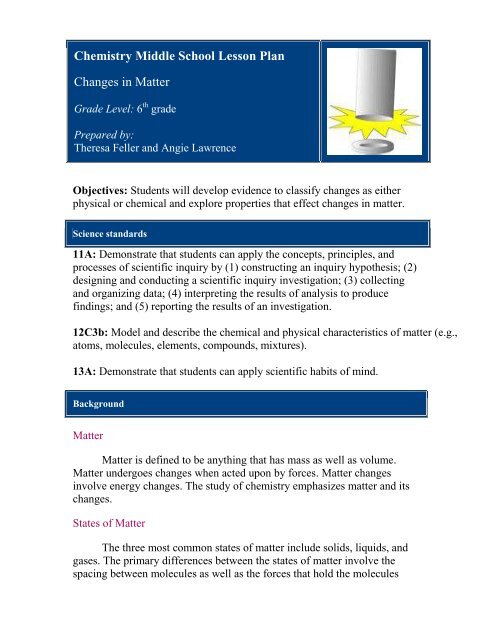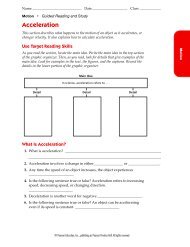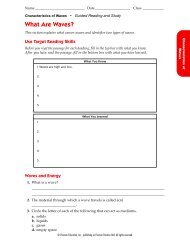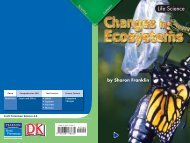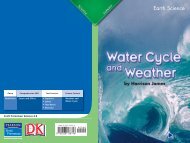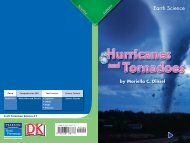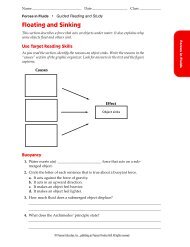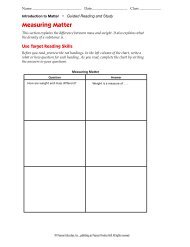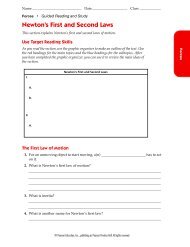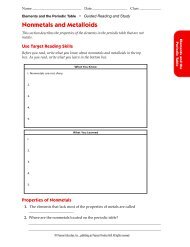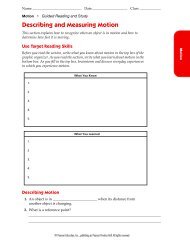Chemical Science Lesson Plan - district87.org
Chemical Science Lesson Plan - district87.org
Chemical Science Lesson Plan - district87.org
Create successful ePaper yourself
Turn your PDF publications into a flip-book with our unique Google optimized e-Paper software.
Chemistry Middle School <strong>Lesson</strong> <strong>Plan</strong><br />
Changes in Matter<br />
Grade Level: 6 th grade<br />
Prepared by:<br />
Theresa Feller and Angie Lawrence<br />
Objectives: Students will develop evidence to classify changes as either<br />
physical or chemical and explore properties that effect changes in matter.<br />
<strong>Science</strong> standards<br />
11A: Demonstrate that students can apply the concepts, principles, and<br />
processes of scientific inquiry by (1) constructing an inquiry hypothesis; (2)<br />
designing and conducting a scientific inquiry investigation; (3) collecting<br />
and organizing data; (4) interpreting the results of analysis to produce<br />
findings; and (5) reporting the results of an investigation.<br />
12C3b: Model and describe the chemical and physical characteristics of matter (e.g.,<br />
atoms, molecules, elements, compounds, mixtures).<br />
13A: Demonstrate that students can apply scientific habits of mind.<br />
Background<br />
Matter<br />
Matter is defined to be anything that has mass as well as volume.<br />
Matter undergoes changes when acted upon by forces. Matter changes<br />
involve energy changes. The study of chemistry emphasizes matter and its<br />
changes.<br />
States of Matter<br />
The three most common states of matter include solids, liquids, and<br />
gases. The primary differences between the states of matter involve the<br />
spacing between molecules as well as the forces that hold the molecules
together. Solids are usually most closely packed, have the most restricted<br />
motion and stronger forces pulling the particles together. Liquids usually are<br />
less dense than solids with intermediate forces and more rotating movements.<br />
Gas particles disperse with very little interactions between molecules and<br />
have quite low density.<br />
Changes in Matter<br />
Changes in matter are generally categorized as physical, chemical, or<br />
nuclear. The physical changes do not create new substances; melting,<br />
evaporation, and dissolving are typical physical changes where the spacing<br />
between the molecules changes without creating a new substance. <strong>Chemical</strong><br />
changes like iron rusting and burning gasoline create new substances. The<br />
creation of a new substance produces new properties like a new color, new<br />
odor or new taste. Another sign that often indicates a chemical change is<br />
bubbling without heating due to the formation of a new gas. Energy changes<br />
accompany all changes in matter but are usually larger and more measurable<br />
in chemical changes. The new substance formed in a chemical is a result of<br />
some change in the reactants on the electron level. The last type of change is<br />
a nuclear change like the nuclear fusion occurring on the sun or nuclear<br />
fission occurring at some power plants. These changes produce huge energy<br />
changes as the nucleus of atoms are changed.<br />
Introduction<br />
Students will classify changes in matter as physical and chemical changes<br />
based on observations recorded in a lab activity. Students will design a plan<br />
to demonstrate pressure change as a result of Alka-Seltzer mixing with water<br />
in a capped film canister. Students will perform an activity that will<br />
demonstrate chemical and/or physical changes and record their observations.<br />
The recorded observations will act as support for their classifying the type of<br />
change based on experimental evidence.<br />
Materials<br />
1. Alka-Seltzer tablets
2. Water in water bottles<br />
3. Film canisters with lids<br />
4. Spatulas<br />
5. Balances<br />
6. Graduated cylinders – small ones 10 – 25 mL<br />
7. Mortar and pestle sets<br />
8. Dropper pipettes<br />
9. Safety goggles/glasses<br />
10. Paper towels<br />
Activity procedure<br />
1. Set Induction: Matter or Not<br />
2. Contrast Physical and <strong>Chemical</strong> Changes<br />
3. Classify examples with think-share-pair groups<br />
4. Pose the question and give instructions for the lab<br />
5. Groups perform investigation and gather data<br />
6. Summarize and critique the groups’ results<br />
7. Individual reflection – exit card “What new ideas or questions do you<br />
have as a result of today’s lesson” “What did you learn about matter<br />
and its properties doing this investigation”<br />
8. Enrichment: Design an experiment that will send the lid or canister<br />
the furthest in the air.<br />
Lab Form and Power Point Presentation Links<br />
Lab Form<br />
Power Point Presentation


